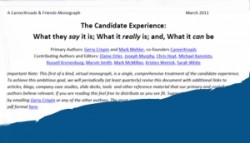 What does “Candidate Experience” mean?
What does “Candidate Experience” mean?
That would seem to be an easy question. But try it and you quickly see how tricky it is to answer.
The candidate experience is the emotional impression created in a person as they proceed through the process of seeking, applying, and being considered for a job with a specific company.
That’s my off-the-cuff answer. Considering a simple Google search turned up 99,000 references to a definition, mine seems as good as any.
Which is exactly the problem Gerry Crispin, Mark Mehler, and friends say is hobbling the industry. It is “evident,” they argue in a new, and provocative monograph, “that the stated opinions are too often unsubstantiated.”
“Unfortunately, among the 100,000 or so people claiming expertise about what the candidate experience is (literary license) the few common themes we have found have little substantive support for their conclusions,” the authors note in the introduction.
Over the following 33 pages, the team details the transformation from hiring — including an entertaining discussion of selection by citrus possession — to recruiting and why, today, candidate experience matters.
“The controversy among staffing professionals isn’t about whether a candidate experience exists,” the authors note, “but why it is so important now when, in the past, employers could generally ignore it at will.”
 Why indeed. With millions out of work and millions more underemployed, why does it matter what the candidate experience is? The short answer is that the better the experience, the better the hire, and the better and more valuable the employee will be. At least, that’s the street wisdom.
Why indeed. With millions out of work and millions more underemployed, why does it matter what the candidate experience is? The short answer is that the better the experience, the better the hire, and the better and more valuable the employee will be. At least, that’s the street wisdom.
You won’t find that spelled out in the monograph, which is a bit unsettling, particularly since gaps between employers who post jobs and take applications, and those offering a best-in-class candidate experience are substantial. Of the Fortune 500 firms surveyed (yes, all 500 of them), only 8 percent (40) earned a best-in-class rating. Almost 60 percent were considered undistinguished or worse.
The team’s criteria for best-in-class is high. Their corporate career sites are mobile-accessible, they offer information about specific jobs and the work environment, navigation is clear, contact information is readily apparent, they engage candidates in two-way conversations via social networks and talent communities, and, though the evidence supporting it is “a mile wide and an inch deep,” they make efforts to say “why a candidate should come and stay.”
By comparison, candidate expectations are meager. A survey by Shaker Consulting Group confirms just how little window shopping job seekers expect. Job descriptions, a place to apply, contact information. Once they actually apply, what they really want is an acknowledgment, a timeline, and to know where they stand, or at least when the job was filled.
As the monograph points out, and the articles it references, and the research by Crispin and Mehler it cites shows, there’s so much more to the candidate experience than that. Which brings us back to just what is that elusive “Candidate Experience?”
It is, offers the team:
“The attitudes and behaviors of individuals who aspire to work for a firm about the recruiting process, the stakeholders in the process, the work and the company itself as a place to work.”